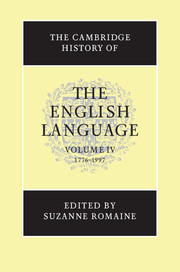1 - INTRODUCTION
Published online by Cambridge University Press: 28 March 2008
Summary
From Old English to new Englishes: unity in diversity?
The final decades of the eighteenth century provide the starting point for this volume – a time when arguably less was happening to shape the structure of the English language than to shape attitudes towards it in a social climate that became increasingly prescriptive. Baugh and Cable (1993) appropriately entitle their chapter on the period from 1650 to 1800 ‘The Appeal to Authority’, characterising the intellectual spirit of the age as one seeking order and stability, both political and linguistic. This so-called Augustan Age was one of refinement. After two centuries of effort to remedy the perceived inadequacies of English to enable it to meet a continually expanding range of functions, the eighteenth century was a time for putting the final touches on it, to fix things once and for all. In the nineteenth century and early part of the twentieth the success of England as an imperial nation combined with romantic ideas about language being the expression of a people's genius would engender a triumphalist and patriotic attitude to English. The language was now not so much to be improved but preserved as a great national monument and defended from threat in a battle over whose norms would prevail. As the demographic shift in the English-speaking population moved away from Britain, the twentieth would be declared the American century, and the Empire would strike back.
The most radical changes to English grammar had already taken place over the roughly one thousand years preceding the starting year of this volume. Certainly MacMahon's chapter makes clear how in our own period the phonology of English underwent nothing like the series of changes called the Great Vowel Shift (see Lass, volume III). It is noteworthy too that changes affecting morphology are insignificant by comparison with those of previous periods.
- Type
- Chapter
- Information
- The Cambridge History of the English Language , pp. 01 - 56Publisher: Cambridge University PressPrint publication year: 1999
References
- 4
- Cited by

